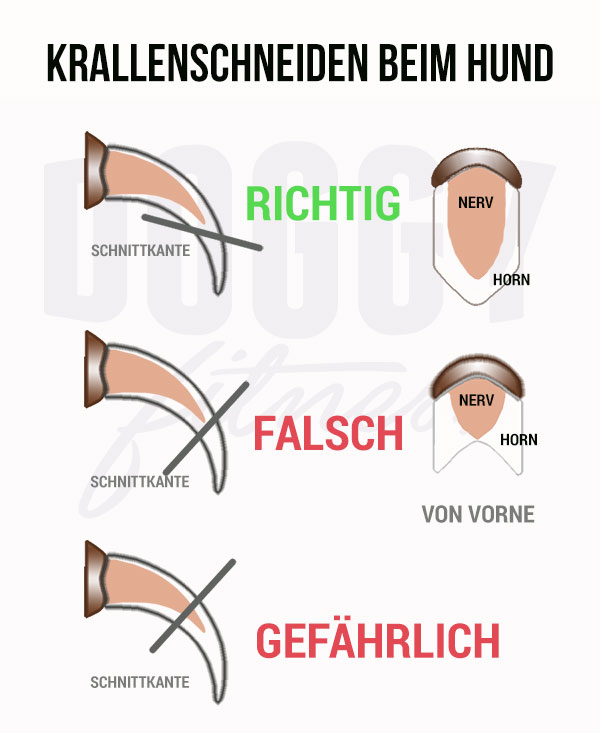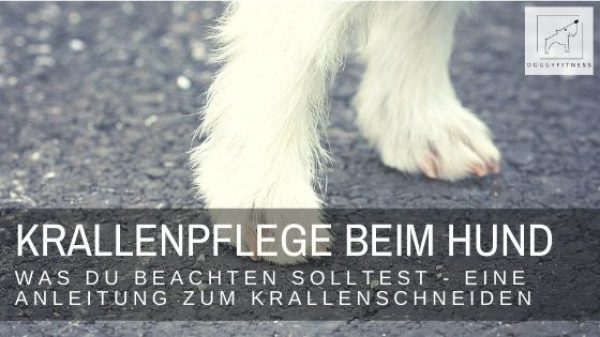Claw trimming in dogs must be learned
The last article was about why claw trimming is so important in dogs and what serious consequences too long claws have on the musculoskeletal system. Often dog owners are unsure of the best way to trim the claws and are afraid to hurt their dog. Therefore, in this article I will tell you how best to trim your dog’s claws.
Cutting claws – the most important thing at the beginning!
If you are not familiar with claw care at all, I recommend that you have your veterinarian, physical therapist, groomer, or veterinary practitioner show you how to do it as many times as you need to until you feel confident enough to do it yourself.
To familiarize your dog with claw trimming, I recommend that you slowly get him used to it. Let him put his paw in your hand, gently massage his toes and touch the claws. Then you should familiarize him with the claw scissors. Show it to him, demonstrate what sounds it makes. Then you touch the claws with the scissors and put them on – without cutting. Only when he is relaxed about all this should you go for the first cut. And never forget the praise!
Where does “life” begin in the claw?
Just like human nails, dog claws are made of horn. However, they are permeated with nerves and blood vessels. You can see them very well in a dog with light colored claws. The biggest fear of most dog owners is injuring the blood vessel in the claw, which is located in the center of the claw along with the nerve that supplies blood to the claw. This not only bleeds heavily, it also hurts the four-legged friend. If your dog has white claws, you can see the blood vessel shimmering light pink from the side and from the front you can see a dot in the center of the claw. If your dog has dark claws, you will not see the blood vessel very well from the side. You should basically cut the claw in very small pieces, millimeter by millimeter. Even if this seems more elaborate at first.
Even if your dog has dark claws, there is a way to see where the blood vessel begins. When viewed from the front, a gray dot will then become visible, indicating to you that this is where life in the claw begins. This way you can see where life begins even in a dog with dark claws. The more often you cut the claws, the further the blood vessels in the claw retract. This also means that you can get even very long claws back to a healthy length with regular care and a little patience.
TIP: Shining a flashlight on dark claws will help you see where the life is in the claw.
The tool – what to cut the claws?
I’ll say it right away: nail scissors for human use are not suitable for quadrupeds! To shorten the claws, there are several types of claw scissors and pliers. With their round cutting surfaces, they exert even pressure on the claw.
With claw nippers, it is important that they are very sharp and fit well in the hand. Especially the “slice by slice” cutting is very easy with it . You can also shorten the claws with a claw grinder. The method is very gentle and fast, but may eventually tickle a bit.
What’s the best way to hold your dog while clipping his claws?
How you position yourself and your dog depends on how big your dog is and how familiar he is with claw trimming. You can hold a smaller dog quite well on your lap, holding the paw in your hand and the claw between your thumb and forefinger. Don’t put too much pressure on the paw, because it can be uncomfortable for your dog and he will pull the paw back. If your dog is excited, a second person can also try to distract your dog with treats. In any case, you should wait for a time when your dog is tired.
How to cut optimally:
You should never cut the claws straight, but as parallel as possible to the nail. This results in the edge shown (photo above right), which prevents the nail from splintering under load. Start at the tip of the claw and cut off a small piece first. Look closely at the cut surface, if it looks callused, you can continue to shorten slice by slice. As soon as the cut surface changes and you see a dot in the middle, stop cutting.
On a black nail, this point is gray. Round the corners with small cuts. The blood vessel is located in the center, as described. You can not hurt your dog on the edges of the claws.

What to do if it does bleed?
With all due caution, it can still happen. You’ve hit a blood vessel and your pelt nose is bleeding. Stay calm yourself so as not to alarm your dog. Put something to stop any bleeding before you cut your claws, flour or starch applied to the claw will stop the bleeding immediately.
One more tip in the end:
If your dog (or YOU) are very afraid of clipping claws, start clipping them one at a time instead of all at once. And lots of praise and calm and possibly a second helping hand often work wonders. So with a little practice, claw trimming is no longer a sweaty horror trip. If you have a young dog, it’s best to get him used to claw trimming right away so that he finds it normal.
PS: You do not know the fatal consequences of too long claws yet? Then you should definitely still read the report claw care in dogs !
Dieser Beitrag ist auch verfügbar auf:
Français (French)
Deutsch (German)
Español (Spanish)
















